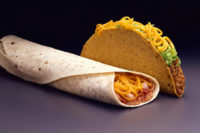Under Wraps
By Deborah Cassell
The tortilla is steadily and stealthily taking over American — and international — bread aisles and foodservice channels with its traditional flour and corn varieties, as well as low-carb, whole grain, organic and flavored creations.
The secret’s out: A staple on every Mexican menu and Hispanic dinner table, the tortilla now is poised for what is no longer a surreptitious takeover as it travels the globe, rivaling its leavened and unleavened competitors in bread aisles and foodservice channels everywhere — from the United States to England, India, Eastern Europe and even some Asian countries.
White, wheat and whole grain loaves, bagels and pitas had best watch their backs.
Driving the tortilla trend here in the United States is the ever-expanding Hispanic population, whose influence on American culture is evident in everything from food — fajitas, burritos, quesadillas — to music — Shakira, Jennifer Lopez, Thalia — to dancing — salsa, tango, rumba.
“It used to be that the strongholds of the tortilla industry were the Southwest —Texas, New Mexico, Arizona, even California,” says John Sommerhalder, CEO of Dallas-based Lobo Tortilla Factory. “That’s no longer true. Tortillas are really pushing strongly into the rest of the country.”
Having moved well beyond the Mexican border and immigrated into mainstream rural and even urban America, the tortilla now is sneaking overseas to other continents and cultures, as well.
“It’s definitely gone global,” says Sommerhalder, citing interest in Czechoslovakia and Turkey, as well as Ireland, England and some Asian countries. “We here in Dallas are currently entertaining an opportunity to make tortillas, ship them to a port, containerize them and have them go across for a European sale.”
Tortillas also are creating a buzz in India, where similar unleavened flat breads such as nan and chapati are popular accompaniments to dishes such as tandoori chicken and murg curry.
“We know that there is a huge demand or a growing demand for tortillas across the world,” says Ricardo Baez, executive vice president of Don Pancho Authentic Mexican Foods, Salem, Ore.
A Corny Accomplice
Depending on where in the world you grew up or your ethnic background, the word “tortilla” conjures up different images, memories, and taste and texture profiles.
The traditional tortilla comes in two varieties: flour and corn. For most non-Hispanic consumers, flour is the tortilla of choice, oft used for family fajita nights and breakfast burritos. But for the Hispanic community, corn takes the cake, particularly among first-generation Mexicans.
“There’s a saying in the Mexican community,” Baez says. “Everything goes with a tortilla. It’s a staple in our diet. You can serve it at the table as tortillas, fold it into tacos, roll it up and make enchiladas. In a Mexican household, a tortilla is something that every family has for every occasion.”
For example, Azteca Foods’ corn tortillas are sold in larger quantities to Mexican-Americans and in smaller quantities to non-Hispanic shoppers, according to Renee Togher, vice president of retail sales and marketing for Chicago-based Azteca.
“If you’re selling a 100-count corn (package), you’re basically selling to the Hispanic market,” she explains.
Viva Variety!
Mainstream America — and many U.S.-born Mexican-Americans — on the other hand, prefers the flour tortilla, which now comes in a number of flavors, from jalapeño to garlic. For example, Azteca’s Baja brand offers sun-dried tomato, spinach, roasted red pepper, four cheese, and vegetable and herb varieties.
“Corn and flour tortillas continue to be the most popular, but we are seeing more consumer interest in flavored tortillas, such as spinach or chipotle,” said Sherry Harper, director of marketing for Flower Foods Bakeries Group, maker of the Mi Casa brand.
Flavors aside, more healthful tortillas also are in demand. Last year’s Atkins craze led to the creation of the low-carb tortilla, which still is enjoying success at retail, despite the death of said diet.
“Our sales on low-carb have continued to steadily decline, but surprisingly enough, they haven’t gone away,” Baez says. “Even though the low-carb doesn’t have the demand that it used to, it’s still a vital component of someone’s diet.”
| The Top 5 | |||||
| Hard/Soft Tortillas/Taco Kits (Latest 52 weeks, ending Feb. 19, 2006) | |||||
| Rank | Brand | Dollar Sales (in millions) | Dollar % Change | Dollar Share | Dollar Share Change |
| 1 | Guerrero | $185.5 | +14.93 | 19.47 | +2.31 |
| 2 | Mission | $156.3 | +9.49 | 16.40 | +1.23 |
| 3 | Old El Paso | $128.8 | +2.32 | 13.52 | +.14 |
| 4 | Private Label | $81.4 | +1.04 | 8.54 | -.02 |
| 5 | Tia Rosa | $41.0 | -2.04 | 4.30 | -.15 |
| TOTAL* | $952.7 | +1.28 | 100.0 | ||
| *Including brands not shown Source: Information Resources Inc., Total U.S. – F/D/MX (Supermarkets, Drugstores and Mass Merchandisers, excluding Wal-Mart) | |||||
The tortillas continue to sell well for Lobo Tortilla Factory, too.
“We had heard that the low-carb was experiencing a decline, but we’re not really seeing it here,” Sommerhalder says. “We’re seeing steady, albeit reduced, demand. But it’s not falling away.”
Togher agrees: “It’s not where it was with the big low-carb craze, but it has leveled out to be a very good item for us.”
While 2005 saw the rise of low-carb, another healthful trend hitting the tortilla category, as well as the bread aisle in general, is whole grain.
“Whole grain is strong,” Sommerhalder says. “I don’t see this as running the risk of being faddish, like low-carb. Consumers are interested in finding a really strong alternative to wheat bread and whole wheat bread, and these whole wheat and whole grain tortilla products are really a wonderful substitute for that.”
Azteca recently introduced a whole grain tortilla in its Buena Vida brand line, influenced by the shrinking white bread aisle.
Whole grain products fit the “good-for-you” trend that’s sweeping America right now, says Baez, whose Don Pancho brand now offers a 7-grain tortilla to meet demand for high-fiber and multigrain breads. Don Pancho also offers certified organic, shelf-stable tortillas in response to consumer interest in more healthful products.
Maximum Exposure
Another trend driving sales of tortillas is the way in which they’re being used. Previously served with Mexican dishes only, today’s tortilla appears on many an eatery menu, most often in the form of a wrap.
“On the foodservice side, there’s a huge influence by a lot of the main players out there that are now featuring wraps,” Baez says. “Subway has a wrap. Arby’s has a wrap. Burger King has a wrap. They’re all over the place.
“The versatility that people are getting exposed to through their foodservice application is really translating to their kitchens,” he adds. In other words, more quick-service and casual restaurant patrons are ordering wraps, as well as making them at home.
“Tortillas can be used at every meal and are no longer limited to just Mexican cuisine,” Harper says. “People can wrap everything from hot dogs to vegetables to scrambled eggs in a tortilla and have a great meal.”
In addition, tortilla wraps are easy to eat. Unlike a hamburger or sandwich, tortillas do not fall apart or lose their contents, bite by messy bite.
“You can basically put a chicken Caesar salad in a wrap and take it on the go,” Sommerhalder suggests. “It’s opening up product possibilities.”
Indeed, the possibilities are endless for this cunning product, which is just as at home on dinner plates in Mexico as it is on American takeout menus. As the Hispanic population continues to grow, so does the tortilla threaten to literally flatten the bread aisle with its multipurpose properties. And that’s a wrap. SF&WB
Original Recipes
Tortillas no longer are reserved for burritos, enchiladas and other traditional Hispanic dishes.
Today, parents send their kids to school with peanut butter and jelly wraps made with the round flatbread, according to Ricardo Baez, executive vice president of Don Pancho Authentic Mexican Foods, Salem, Ore.
In fact, consumers are all about the “wrap,” as evidenced by foodservice channel menus, where the Chicken Caesar Wrap has become as common as chicken fingers and French fries.
“The non-Hispanic population has really taken this product and given it a twist,” Baez says.
Chicago-based tortilla manufacturer Azteca inspires shoppers to create non-traditional snacks and meals with its product by featuring recipes on the back of its packages — which it refreshes every four weeks — for such concoctions as Fruit Pizza and French Toast Wraps.
“We try to give recipes that aren’t just Mexican foods,” says Renee Togher, vice president of retail sales and marketing for Azteca.
The manufacturer also offers interesting suggestions on its Web site, www.aztecafoods.com, including Turkey, Dressing & Cranberry Wraps; Apple Cinnamon Rollups; Pizza Foldovers; Cheesy Tortilla Wedges; Hot Chili Cheese Triangles; Salami Pinwheels and Mexican Lasagna. Consumers can obtain a free copy of Azteca’s “Roll out the fun!” recipe book online, as well.



